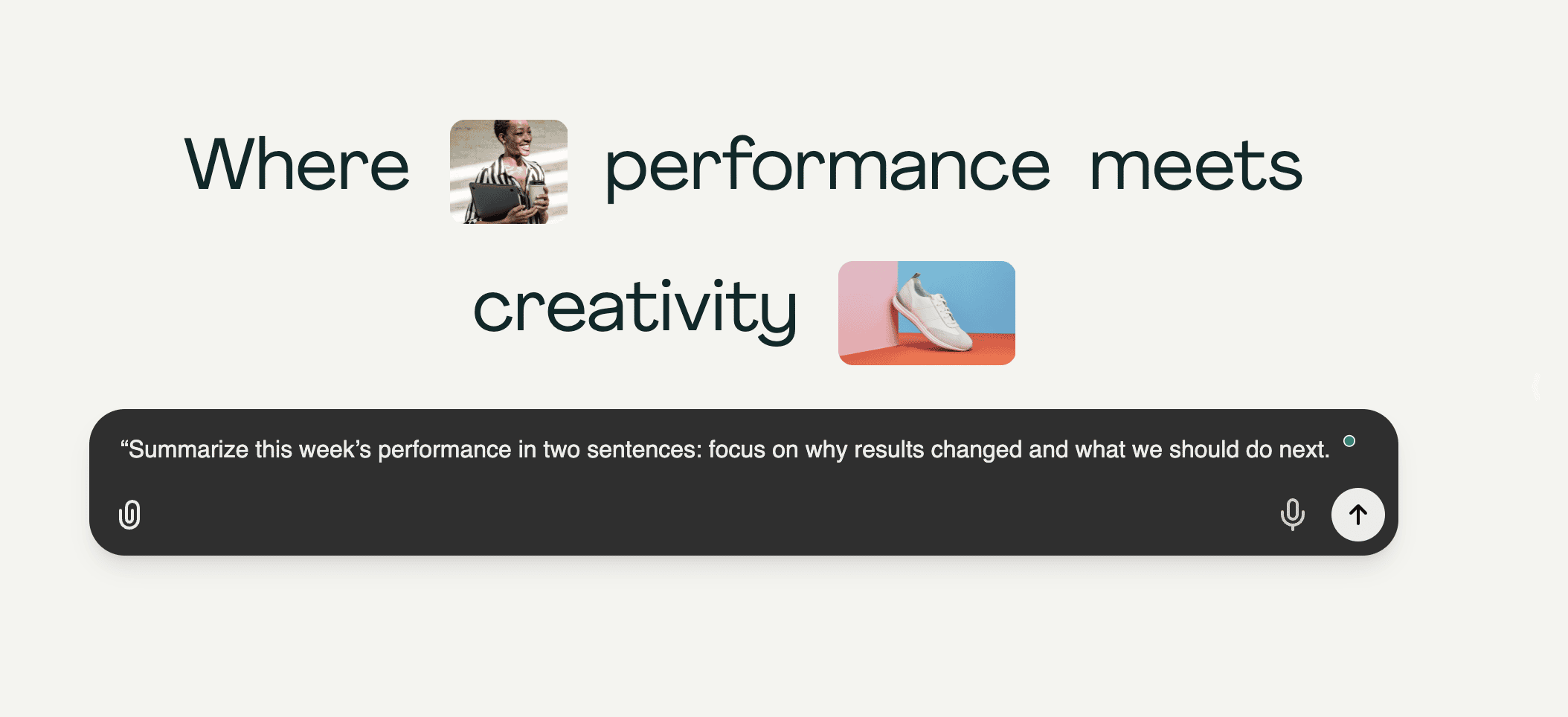The Problem I Didn’t Realize I Had
A few years ago, I walked into a client review armed with what I thought was a rock-solid report.
I had charts, platform screenshots, trend lines — everything that showed exactly what was happening in our campaigns.
Five minutes in, someone asked,
“So, should we increase spend or pull back?”
I remember freezing for a second, because the answer wasn’t on any of my slides.
I had built a perfect explanation, not a decision.
That moment changed how I approach performance altogether.
As marketers, we love the details — CTR shifts, CPC trends, creative fatigue curves. But what I learned that day is that none of that matters if I can’t connect it to why something happened and what we’re going to do about it.
Executives don’t want the mechanics of performance. They want the meaning behind it.
And that’s where most of us lose them.
The Gap We Keep Missing
Every marketer I know works hard to make their reports clear. We shorten paragraphs, color-code dashboards, and call it “storytelling.” But clarity isn’t the issue — translation is.
We speak the language of platforms. Our stakeholders speak the language of business.
And somewhere between those two dialects, insight gets lost.
That’s the gap this piece addresses.
Because in today’s environment, where every team has access to real-time data, clarity has become the real differentiator. The faster we can turn numbers into direction, the more value we bring to the table.
What the Boardroom Actually Wants
I’ve come to realize that executive teams only need two things from us:
- Why performance changed.
- What we’re doing next.
That’s it.
The rest — platform details, test breakdowns, creative analysis — supports those two answers.
So when I summarize performance now, I don’t say:
“CTR dropped by 10%, CPC increased by 15%, so ROAS fell.”
I say:
“Competition intensified, which drove up costs and reduced efficiency. We can either spend more to protect volume or optimize to stabilize ROAS.”
That shift — from description to direction — changes everything.
It makes the conversation forward-looking. It earns trust. And it makes every data point worth the time it took to gather.
Why This Isn’t Just About Simplifying
It’s tempting to call this “simplifying” or “telling stories,” but that doesn’t quite capture it.
What we’re doing here is establishing alignment — between the marketer’s understanding of data and the executive’s understanding of business reality.
When those two align, something interesting happens:
- Decisions get made faster.
- Strategies stay consistent.
- Performance feedback loops shorten.
It’s not about making reports prettier; it’s about making them actionable.
That’s the real need this process fulfills.
Where AI Steps In
Before AI, this translation was slow. I’d spend 30–40 minutes pivoting data, cross-referencing views, jotting down observations, and rewriting until it “sounded right.”
Now, I can drop the dataset into Prism and ask it to:

Within minutes, I get a structured synthesis — not a report, but a briefing.
It saves me time, yes, but more importantly, it surfaces correlations I might’ve overlooked: creative fatigue trends, audience overlaps, small spend anomalies.
That’s the kind of detail that builds credibility when you’re speaking to leadership.
You’re essentially diagnosing the performance.
And that’s the gap AI fills in my day-to-day: it turns translation from an art into a process.
When Strategy Flows the Other Way
The translation challenge works both ways.
Sometimes leadership starts the conversation — “We need to optimize for revenue this quarter.”
That’s when I reverse-engineer the direction back into metrics.
With Prism, I can trace which factors correlate most strongly with revenue shifts — rising CPCs, shrinking conversion rates, creative fatigue — and map them to actionable levers.
The end result? The same clarity, but in reverse.
Executives understand how strategy translates to action, and teams understand how actions ladder back to strategy.
It’s one shared language, just spoken in two directions.
The Real Impact: Credibility and Speed
Once you start communicating this way, everything changes.
Clients stop reacting to numbers — they start engaging with insights.
Executives stop skimming — they start deciding.
That’s when you stop being “the person who knows the platforms” and become “the person who drives outcomes.”
And that’s the shift AI enables when it’s used right — not as a content generator, but as a cognitive partner.
It helps you see what matters, faster, and express it in a way that actually moves things forward.
Why This Conversation Belongs to Pixis
At Pixis, we’ve spent years proving how AI can scale creative, optimize media, and surface insights.
But there’s a quieter, equally powerful story unfolding underneath all that:
AI as a translator of intelligence — between marketers, data, and leadership.
That’s what Prism does best.
It communicates the numbers and gives marketers a voice that executives immediately understand. And that leads to a more aligned future for performance marketing.
How I’d Start if I Were You
If you’re a marketer trying to make your insights land with leadership, here’s what I’d suggest:
- Build every update around “why” and “what now.”
If it doesn’t answer those, it doesn’t belong in the meeting. - Use AI as your interpreter, not your storyteller.
Let tools like Prism surface direction; you bring the context. - Check your own clarity.
If you can’t summarize a campaign in two sentences, you probably don’t understand it deeply enough. - Rebuild feedback loops.
Use the same clarity you want from leadership to help your creative and media teams see how their work connects to results.
It’s a habit — but it’s one that changes your position in every room you walk into.
Closing Thoughts
The hardest part of marketing is and persuasion starts with clarity.
We’ve reached a point where everyone has dashboards, AI summaries, and automation scripts.
What few people have is the ability to speak about performance in a way that earns trust.
That’s what I’ve been learning through Prism — that AI can’t replace human understanding, but it can amplify it. When it takes care of the mechanics, I finally have room to focus on meaning.
So the next time you’re asked for an update, skip the metrics slide.
Start with the sentence that tells them why it happened — and end with what you’ll do next.
That’s how you make the data — and yourself — matter in the boardroom.
In case you'd like to give it a go,

